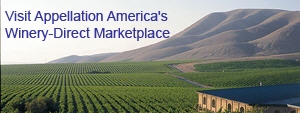

A wine symposium in Santa Ynez Valley tried to thrash this out.
The Syrah Conundrum:
When Will it Get Respect?
Will Syrah be the next popular varietal the way Merlot and Pinot Noir have been? The crush of Australian Shiraz imports in the U.S. has not only confused American wine consumers by the grape's name but also undercut the value of California Syrah with low pricing.
by
Dennis Schaefer
January 22, 2008
 t was back in 1974 that Christian Brothers Winery sold Joseph Phelps Vineyards in Napa a paltry ten tons of Syrah (which the Brothers had always buried in their blends) plus budwood to plant their own Syrah. When that Syrah was finally released in 1977, it was probably the first time since Prohibition that a California Syrah was commercially available and
t was back in 1974 that Christian Brothers Winery sold Joseph Phelps Vineyards in Napa a paltry ten tons of Syrah (which the Brothers had always buried in their blends) plus budwood to plant their own Syrah. When that Syrah was finally released in 1977, it was probably the first time since Prohibition that a California Syrah was commercially available and 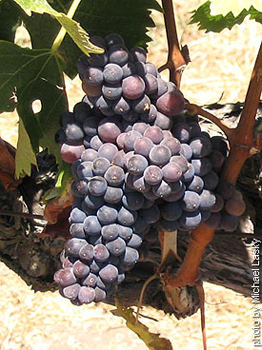 released under its varietal name. Meanwhile, on the Central Coast, Gary Eberle had planted Syrah at what was then called Estrella River Winery (now Meridian Vineyards).
released under its varietal name. Meanwhile, on the Central Coast, Gary Eberle had planted Syrah at what was then called Estrella River Winery (now Meridian Vineyards).
Later Zaca Mesa Winery would start making Syrah (the first in Santa Barbara County) and Estrella would often sell their Syrah grapes to upstarts like Bob Lindquist of Qupe’ Wine Cellars or Randall Grahm of Bonny Doon Vineyard. And the thing snowballed from there into more vineyard plantings and then a loose-knit group of like-minded winemakers dubbed The Rhone Rangers.
At this point, Syrah is planted up and down the California coast and there are a multitude of producers. In fact, Syrah’s growth has been nearly exponential: only around 500 tons of grapes were crushed back in 1990, while in the early part of this decade, it had hovered around 100,000 tons per year. Then in 2005, the tonnage jumped to 147,312 tons and more is planted and on its way in the pipeline.
But since Syrah “is now blossoming in American vineyards” and beginning to “muscle its way into the American mainstream,” (from USA Today in 2001), I scratched my head in quizzical disbelief because I have been beating the drum for Rhone varietals for the last two decades. I boldly confess that I’d rather drink Syrah over Cabernet Sauvignon any day.
The Syrah Symposium
So I was quite curious to attend a “Syrah Symposium,” designed for the press and trade, recently in Santa Ynez Valley, to either confirm or deny my hypothesis. The Syrah Symposium was hosted by four Santa Ynez Valley wineries: Bridlewood, Beckmen, Fess Parker, and Zaca Mesa, although there was a ringer from Napa in Palmeri.“Syrah is becoming a superstar in elite growing regions around the world; different styles are emerging, along with new learnings from the vineyard and the cellar,” explained Bridlewood winemaker, David Hopkins. “We though it would be a good idea to get some folks together and share what we’ve learned
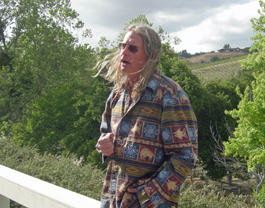
With the Bridlewood Estate Vineyard in the background, David Hopkins talks about its Syrah.
There were quite a number of informative, and sometimes technical, seminars that focused on what was unique about Syrah. Peter Neptune MS, Vice President of Wine Education for The Henry Wine Group, moderated the seminar discussions, and gave the first presentation on the history of Syrah. It’s interesting to note, Neptune said, that Syrah did not originate in the city of Shiraz in Iran, as many stories have it, but most likely originated from the vineyards of the Northern Rhone. More recent DNA studies by UC Davis have concluded that Syrah is the result of a cross of the “Dureza” and “Mondeuse Blanche” grape varieties, probably emanating from the slopes of Hermitage.
Perhaps the most interesting seminar was the first field trip of the symposium to Beckmen Vineyards’ 365 acre, biodynamically farmed Purisima Mountain Vineyard. The vineyard was planted in 1996, but only went the totally biodynamic route in 2006. After doing quality control and consistency trials on a small portion of the vineyard, vintner Steve Beckmen committed the entire
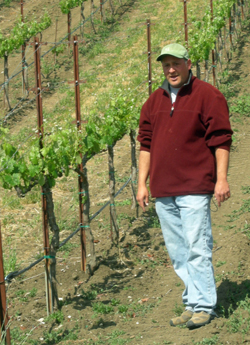
Steve Beckmen explains biodynamics at his biodynamically farmed Purisima Mountain Vineyard in Santa Ynez Valley.
The Napa interloper, Palmeri’s Kerry Damskey, extolled the virtues of mountain grown Syrah, as exemplified in his bottlings from Stagecoach Vineyard in Napa and Van Ness Vineyard in Sonoma’s Alexander Valley. The benefits for Syrah are obvious, he said. Mountain soils are limiting; mountain vineyards are cooler; mountain vineyard get more sunlight and more hang time. He might have said, mountain grown wines are more tightly wound, are seemingly deeper and richer than valley floor grown wines, but do take longer to develop in the bottle.
In another field trip, Clay Brock of Zaca Mesa showed off what is now the oldest Syrah vineyard on the Central Coast: the Black Bear Block, planted in 1979. Gary Eberle had planted Syrah in Paso Robles in 1977, but those vines have since been ripped out. The Black Bear Block, however, is planted from cuttings provided by Eberle, now commonly called the Estrella River clone, from suitcase cuttings
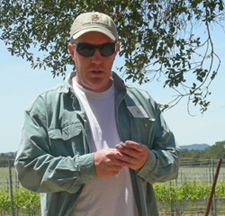
Clay Brock says he’s tired of seeing Syrah categorized as the “other red” on wine lists and in wine stores.










 READER FEEDBACK: To post your comments on this story,
READER FEEDBACK: To post your comments on this story,

